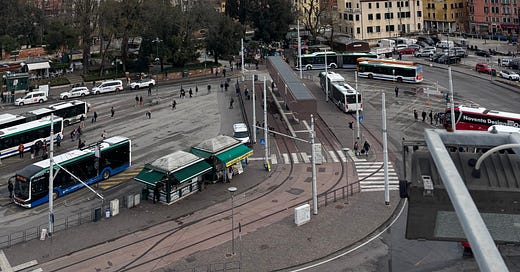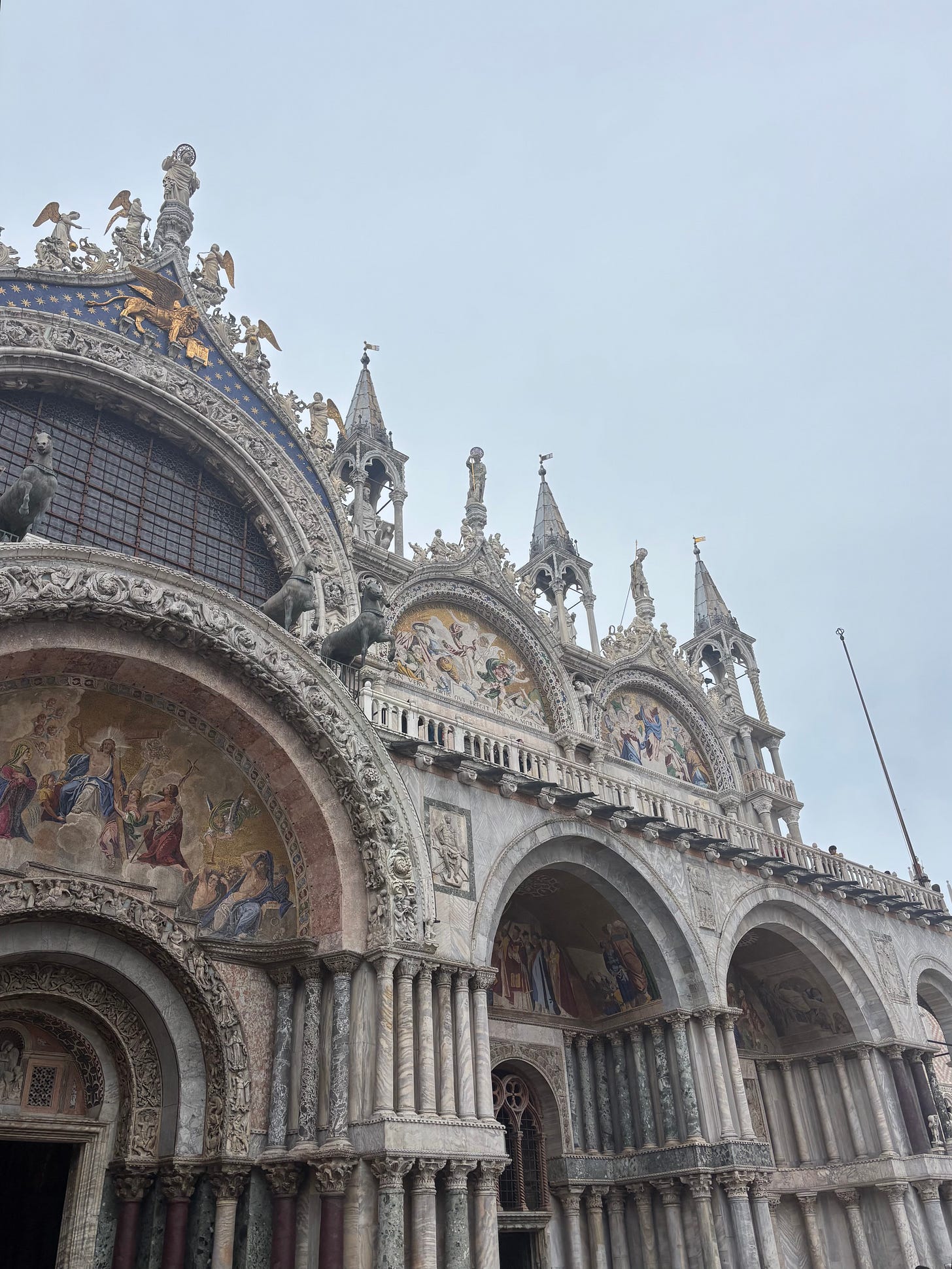“You return from distant lands and you can tell me only the thoughts that come to a man who sits on his doorstep at evening to enjoy the cool air. What is the use then of all your traveling?”
-Kublai Khan to Marco Polo in Italo Calvino’s Invisible Cities
Last Friday I visited Venice. I went to Italy for work, and stopped there before flying back to America. I spent just five hours in the city, but that felt like enough for a place I’d seen in images many times before.
Venice didn’t feel real to me but it was beautiful. It’s two miles off the coast, connected to mainland Italy by a long bridge, or by boat, so already it feels so separate from the rest of the world. The city consists of a series of small islands linked by bridges. Between the bridges are canals, the watery thoroughfares of Venice, where its famous gondoliers paddle. It’s impractical to live on a canal island city in our modern world of cars, but Venice has been preserved into the modern world in the exact shape of its medieval mercantile origins.
I drove a rental car across the bridge to Venice. At the front of the city there are a few giant parking decks, a big roundabout for buses to drop people off, and a train station. Beyond that point, there are no intrusive modern buildings anywhere, and no cars. It’s just quaint narrow cobbled streets and centuries-old buildings, on every inch of Venice’s original layout.
Venice’s preserved cityscape gave me a glimpse of what day-to-day life might have been like for someone in the 1200s. I imagined someone waking up in mercantile Venice, coming down from their apartment to the same streets I stood on, walking to the harbor to unpack goods, spending the afternoon in one of the many town squares, and spending the evening in one of the many Catholic churches. This is similar to how I think people feel at Civil War reenactments.
The original medieval Venice, once a vibrant living place, has today turned itself into a museum, or a theme park. Nearly everyone walking through the city alongside me was a tourist, like me, visiting a famous place they'd heard of before. The place has been preserved for our eyes, and restaurants and gift shops have been built on every corner for our sake. I enjoyed my walk through the Venice theme park. I liked the canals, the buildings, and the statues. Everything was exciting and new to my fresh eyes. In America we don’t have buildings this old, or water quite this close to us.
Venetian streets are winding, with no grid like modern cities have. Sometimes the streets pass underneath buildings. It was hard to navigate the city with Google Maps, because my phone couldn’t get a signal down the skinny gaps between buildings. But I never felt at risk of getting lost in a way where I’d be unsafe or inconvenienced. Everything was clean. There aren’t homeless people, and there’s no garbage on the streets.
I was guided at all times by yellow metal signs posted on the stone walls, which read “Per S. Marco” or “Per Rialto” with an arrow. These signs point tourists toward the two largest attractions in Venice.
The Rialto bridge is in the center of the city. It’s a white marble bridge, which itself is very striking, but also gives views of Venice’s central Grand Canal.
Piazza San Marco is at the edge of the city near the water. It holds Venice’s largest cathedral, St. Mark’s Basilica. It has pillars made of colored granite, and a gold-leafed ceiling. The colors are over-the-top to modern eyes and it’s hard to imagine how they felt to the many older eyes that have seen it. Nearby is the Doge’s palace, which I sadly did not enter due to time constraints. The plaza also has a big clocktower which gives panoramic views of Venice. The clocktower looks original from the outside, but on the inside it’s been modified to hold an elevator to bring tourists to the top.
Once I finished in the plaza, I walked back through the city towards my car, and I was guided by more yellow signs.
The main reason Venice has been preserved is for the experience I had there; a walk through its stone streets, over watery canals, past gift shops and restaurants and ice cream parlors on the way to the two main tourist areas. It’s a nice way to spend a day; almost everyone would enjoy it. But it doesn’t feel like a real city because there’s nothing happening to it. Venice is preserved in amber by human efforts, against the advents of modern convenience. No families live there, no corporations set up offices there. It’s a story now. I think Venice might feel boring after a while, because it doesn’t feel real, but I’m glad I saw it once with my own eyes.
To be clear, this is not a new insight. Venice has been this way for a while. It’s how Thomas Mann described it a hundred years ago in Death in Venice, as a city that’s distinctly not alive compared to Paris or Berlin. But I think that it’s become even more true over time. Technology like cars and highways pushed Venice farther from being alive as a city. And more recent technology has made Venice more relevant as a tourist destination. Smartphones allow anyone to take a photo in Venice and leave themselves in the canals on their Instagram grid forever, even if they’re only in Venice for a single day. Venice can be a part of your identity if you’re just there once, so the tourism means more.
But I don’t want to be too harsh to Venice. Other cities are like this too when we travel. Walking through a city to see its famous landmarks, eat nice food, and take pictures is how many vacations are structured. This is especially true for Americans visiting Europe, because it’s a contrast to how we live our lives normally. We like to go to Europe and see the old things that have been preserved. We like to walk around instead of using our cars. Even in more alive European cities, we spend our vacation days like this.
Venice is a calibrated mechanical experience, which on paper isn’t fun, because as humans we want to be independent agents in the world, making our own paths. Alive cities make us feel that way more; a tourist could in theory stumble into a Parisian fashion party when they visit, and change the course of the world. Venice is more beautiful than most cities, maybe all cities, so it can get away without giving tourists that feeling of agency. Everyone visiting knows the Venice we see today isn’t organic or alive, and that we can’t make a mark on it. We’re going there to walk around the museum.
Is there anything wrong with that? Could walking around seeing pretty things be all we need? I think so. But we can do that anywhere, if we know how to look at the world.








We need more coldhealing city reviews!
I love your depiction of the city. No matter the countless pictures of Venice I see on Instagram, my mind always imagines the Overwatch map Rialto.